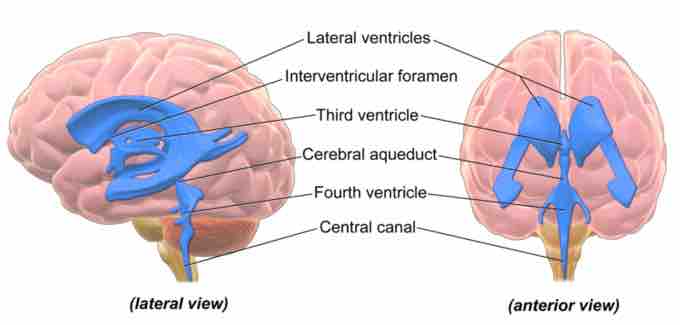The ventricular system is a set of four interconnected cavities (ventricles) in the brain and the location of CSF production. This system is continuous with the central canal of the spinal cord.
The system comprises four ventricles:
- right and left lateral ventricles (the first and second ventricles)
- third ventricle
- fourth ventricle
CSF Production
The cavities of the cerebral hemispheres are called lateral ventricles or first and second ventricles. These two ventricles open into the third ventricle by a common opening called the foramen of Monro.
CSF is produced by modified ependymal cells of the choroid plexus found in all components of the ventricular system except for the cerebral aqueduct and the posterior and anterior horns of the lateral ventricles. The brain and spinal cord are covered by a series of tough membranes called meninges, which protect these organs from rubbing against the bones of the skull and spine. The CSF within the skull and spine is found between the pia mater and the arachnoid and provides further cushioning. EndFra
CSF Flow Within Ventricles
CSF flows from the lateral ventricles via the foramina of Monro into the third ventricle, and then into the fourth ventricle via the cerebral aqueduct in the brainstem. From there, it passes into the central canal of the spinal cord and into the cisterns of the subarachnoid space via three small foramina: the central foramen of Magendie and the two lateral foramina of Luschka. The fluid then flows around the superior sagittal sinus to be reabsorbed via the arachnoid villi into the venous system. CSF within the spinal cord can flow all the way down to the lumbar cistern at the end of the cord around the cauda equina.

Brain Ventricles
Lateral and anterior views of the brain ventricles, including the third and fourth ventricle, lateral ventricles, interventricular foramen, cerebral aqueduct, and central canal.
Ventricular System Dysfunction and Disease
Diseases of the ventricular system include abnormal enlargement (hydrocephalus) and inflammation of the CSF spaces (meningitis, ventriculitis) caused by infection or introduction of blood following trauma or hemorrhage. The aqueduct between the third and fourth ventricles is very small, as are the foramina. This means they can be easily blocked, causing high pressure in the lateral ventricles. This is a common cause of hydrocephalus (known colloquially as "water on the brain"), an extremely serious condition due to the damage caused by the pressure as well as the nature of the block (e.g., a tumor or inflammatory swelling).
Embryonic Development of the Ventricles
The structures of the ventricular system are embryologically derived from the center of the neural tube (the neural canal). As the future brain stem aspect of the primitive neural tube develops, the neural canal expands dorsally and laterally, creating the fourth ventricle. The cerebral aqueduct is formed from the part of the neural canal that does not expand and remains the same at the level of the midbrain superior to the fourth ventricle. The fourth ventricle narrows at the obex, where the fourth ventricle narrows to become the central canal in the caudal medulla.